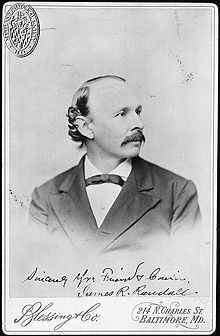James Ryder Randall
James Ryder Randall | |
|---|---|
 | |
| Born | January 1, 1839 Baltimore, Maryland, U.S. |
| Died | January 15, 1908 (aged 69) Augusta, Georgia, U.S. |
| Occupation | Journalist Poet |
| Nationality | American |
| Genre | Poetry |

James Ryder Randall (January 1, 1839 – January 15, 1908) was an American journalist and poet. He is best remembered as the author of "Maryland, My Maryland".
Biography[]
Randall was born on January 1, 1839 in Baltimore, Maryland. He was named after Father James A. Ryder S.J., the 20th President of Georgetown University.[citation needed]
He is most remembered for writing the poem "Maryland, My Maryland," which is also the reason for his being called the "Poet Laureate of the Lost Cause". It became a war hymn of the Confederacy after the poem's words were set to the tune "Lauriger Horatius" (the tune of O Tannenbaum) during the Civil War by Jennie Cary, a member of a prominent Maryland and Virginia family. It later became the state song of Maryland.[1]
Randall wrote the poem after learning that his friend Francis X. Ward, of Randallstown, Maryland, was killed by the 6th Massachusetts Militia in the Baltimore Riot of April 19, 1861.[2] The work was first published a week later on April 26, in the New Orleans newspaper The Sunday Delta.[3]
After abandoning his studies at Georgetown University, he traveled to South America and the West Indies. Upon his return to the United States he taught English literature at Poydras College in Pointe Coupee Parish, Louisiana. It was during this time that he penned "Maryland, My Maryland". Tuberculosis prevented him from enlisting in the Confederate Army.[4] However, he was able to serve with the Confederate States Navy in Wilmington, North Carolina. Though a Marylander by birth, he wrote the poem "Maryland, My Maryland" while living in Augusta, Georgia. He considered himself a Georgian by adoption.[5][6] After the Civil War, Randall became a newspaper editor and a correspondent in Washington, D.C., for The Augusta Chronicle. He continued to write poems, although none achieved the popularity of "Maryland, My Maryland". His later poems were deeply religious in nature.[3]
He died on January 15, 1908 in Augusta, Georgia, and is buried there in Magnolia Cemetery.[7] Augusta honors him on the Monument to Poets of Georgia along with Fr. Abram Ryan, Sydney Lanier, and Paul Hamilton Hayne, all of whom saw Confederate service.[8] The Randall Memorial Committee of Chapter "A" United Daughters of the Confederacy Augusta, Georgia, dedicated a statue to him there in 1936.[9] James Ryder Randall Elementary School in Clinton, Maryland, bears his name.[10]
References[]
- ^ Maryland State Archives (2004). Maryland State Song – "Maryland, My Maryland".
- ^ Phair, Monty. "A Brief History of Randallstown". Baltimore County Public Libraries. Archived from the original on 2016-12-11. Retrieved 2012-12-05.
- ^ Jump up to: a b Dwyer, William (1911). "James Ryder Randall". The Catholic Encyclopedia. 12. New York: Robert Appleton Company. Retrieved October 12, 2009.
- ^ "James Ryder Randall". baltimoreauthors.ubalt.edu. Retrieved 23 September 2017.
- ^ A Standard History of Georgia and Georgians, Volume 3 By Lucian Lamar Knight page 1283
- ^ "James Ryder Randall Papers, 1855-1864; 1905-1912". 2.lib.unc.edu. Retrieved 23 September 2017.
- ^ "Tour highlights Civil War sites in Augusta". Retrieved 23 September 2017.
- ^ "Monument to the Poets of Georgia Augusta Georgia". Ohwy.com. Retrieved 23 September 2017.
- ^ "Frankies Confederate Monuments and Memorials of the South". Oocities.org. Retrieved 23 September 2017.
- ^ "Home". 1.pgcps.org. Retrieved 23 September 2017.
External links[]
| Wikisource has original works written by or about: James Ryder Randall |
| Wikiquote has quotations related to: James Ryder Randall |
| Wikimedia Commons has media related to James Ryder Randall. |
- Biography at Catholic Encyclopedia
- James Ryder Randall at Find a Grave
- Sheet music for "There's life in the old land yet", Augusta, GA: Blackmar & Bro, from the Confederate Imprints Sheet Music Collection
- 1839 births
- 1908 deaths
- American male journalists
- 19th-century American poets
- American male poets
- People of Maryland in the American Civil War
- Confederate States Navy officers
- 19th-century American male writers
- Philodemic Society members